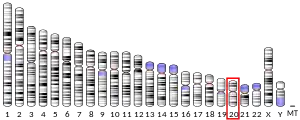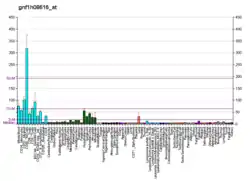Phosphatidylinositol 3,4,5-trisphosphate-dependent Rac exchanger 1 protein is a protein that in humans is encoded by the PREX1 gene.[5][6][7][8]
Function
The protein encoded by this gene acts as a guanine nucleotide exchange factor for the RHO family of small GTP-binding proteins (RACs). It has been shown to bind to and activate RAC1 by exchanging bound GDP for free GTP. The encoded protein, which is found mainly in the cytoplasm, is activated by phosphatidylinositol-3,4,5-trisphosphate and the beta-gamma subunits of heterotrimeric G proteins.[8] The activation of P-REX1 is efficient when chemotactic receptors coupled to Gi proteins are activated, as a consequence of a better release of the Gβɣ heterodimer.[9]
Clinical significance
The protein has been implicated in the spread of melanoma skin cancer.[10]
References
- 1 2 3 GRCh38: Ensembl release 89: ENSG00000124126 - Ensembl, May 2017
- 1 2 3 GRCm38: Ensembl release 89: ENSMUSG00000039621 - Ensembl, May 2017
- ↑ "Human PubMed Reference:". National Center for Biotechnology Information, U.S. National Library of Medicine.
- ↑ "Mouse PubMed Reference:". National Center for Biotechnology Information, U.S. National Library of Medicine.
- ↑ Welch HC, Coadwell WJ, Ellson CD, Ferguson GJ, Andrews SR, Erdjument-Bromage H, et al. (March 2002). "P-Rex1, a PtdIns(3,4,5)P3- and Gbetagamma-regulated guanine-nucleotide exchange factor for Rac". Cell. 108 (6): 809–21. doi:10.1016/S0092-8674(02)00663-3. PMID 11955434. S2CID 14185057.
- ↑ Hill K, Krugmann S, Andrews SR, Coadwell WJ, Finan P, Welch HC, et al. (February 2005). "Regulation of P-Rex1 by phosphatidylinositol (3,4,5)-trisphosphate and Gbetagamma subunits". The Journal of Biological Chemistry. 280 (6): 4166–73. doi:10.1074/jbc.M411262200. PMID 15545267.
- ↑ Mayeenuddin LH, Garrison JC (January 2006). "Phosphorylation of P-Rex1 by the cyclic AMP-dependent protein kinase inhibits the phosphatidylinositiol (3,4,5)-trisphosphate and Gbetagamma-mediated regulation of its activity". The Journal of Biological Chemistry. 281 (4): 1921–8. doi:10.1074/jbc.M506035200. PMID 16301320.
- 1 2 "Entrez Gene: PREX1 phosphatidylinositol 3,4,5-trisphosphate-dependent RAC exchanger 1".
- ↑ Cervantes-Villagrana RD, Adame-García SR, García-Jiménez I, Color-Aparicio VM, Beltrán-Navarro YM, König GM, et al. (January 2019). "13 proteins". The Journal of Biological Chemistry. 294 (2): 531–546. doi:10.1074/jbc.RA118.006254. PMC 6333895. PMID 30446620.
- ↑ Lindsay CR, Lawn S, Campbell AD, Faller WJ, Rambow F, Mort RL, et al. (November 2011). "P-Rex1 is required for efficient melanoblast migration and melanoma metastasis". Nature Communications. 2: 555. Bibcode:2011NatCo...2..555L. doi:10.1038/ncomms1560. PMC 3400057. PMID 22109529.
- "Protein linked to spread of skin cancer". Cancer Research UK. 22 November 2011. Archived from the original on 2011-11-25.
Further reading
- Nakajima D, Okazaki N, Yamakawa H, Kikuno R, Ohara O, Nagase T (June 2002). "Construction of expression-ready cDNA clones for KIAA genes: manual curation of 330 KIAA cDNA clones". DNA Research. 9 (3): 99–106. doi:10.1093/dnares/9.3.99. PMID 12168954.
- Nagase T, Kikuno R, Ishikawa KI, Hirosawa M, Ohara O (February 2000). "Prediction of the coding sequences of unidentified human genes. XVI. The complete sequences of 150 new cDNA clones from brain which code for large proteins in vitro". DNA Research. 7 (1): 65–73. doi:10.1093/dnares/7.1.65. PMID 10718198.
- Wiemann S, Weil B, Wellenreuther R, Gassenhuber J, Glassl S, Ansorge W, et al. (March 2001). "Toward a catalog of human genes and proteins: sequencing and analysis of 500 novel complete protein coding human cDNAs". Genome Research. 11 (3): 422–35. doi:10.1101/gr.GR1547R. PMC 311072. PMID 11230166.
- Fossey SC, Mychaleckyj JC, Pendleton JK, Snyder JR, Bensen JT, Hirakawa S, et al. (August 2001). "A high-resolution 6.0-megabase transcript map of the type 2 diabetes susceptibility region on human chromosome 20". Genomics. 76 (1–3): 45–57. doi:10.1006/geno.2001.6584. PMID 11549316.
- Weiner OD (June 2002). "Rac activation: P-Rex1 - a convergence point for PIP(3) and Gbetagamma?". Current Biology. 12 (12): R429-31. doi:10.1016/S0960-9822(02)00917-X. PMC 2819105. PMID 12123595.
- Zhao T, Nalbant P, Hoshino M, Dong X, Wu D, Bokoch GM (April 2007). "Signaling requirements for translocation of P-Rex1, a key Rac2 exchange factor involved in chemoattractant-stimulated human neutrophil function". Journal of Leukocyte Biology. 81 (4): 1127–36. doi:10.1189/jlb.0406251. PMID 17227822. S2CID 25318452.
- Ewing RM, Chu P, Elisma F, Li H, Taylor P, Climie S, et al. (2007). "Large-scale mapping of human protein-protein interactions by mass spectrometry". Molecular Systems Biology. 3 (1): 89. doi:10.1038/msb4100134. PMC 1847948. PMID 17353931.
- Hernández-Negrete I, Carretero-Ortega J, Rosenfeldt H, Hernández-García R, Calderón-Salinas JV, Reyes-Cruz G, et al. (August 2007). "P-Rex1 links mammalian target of rapamycin signaling to Rac activation and cell migration". The Journal of Biological Chemistry. 282 (32): 23708–15. doi:10.1074/jbc.M703771200. PMID 17565979.
- Barber MA, Donald S, Thelen S, Anderson KE, Thelen M, Welch HC (October 2007). "Membrane translocation of P-Rex1 is mediated by G protein betagamma subunits and phosphoinositide 3-kinase". The Journal of Biological Chemistry. 282 (41): 29967–76. doi:10.1074/jbc.M701877200. PMID 17698854.




